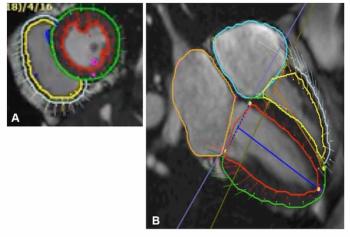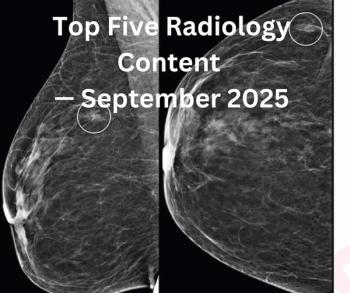
Cardiac CT exhibits clinical, cost benefits despite radiation risk
Dual-source or 64-slice CT examination proves quick, noninvasive, and effective in triaging patients with low to moderate risk of heart disease
Increasing efforts to screen and diagnose coronary artery disease have used imaging modalities such as catheter angiography, ultrasound, and MRI. Electron-beam CT was, for a long time, the only CT system able to image the coronary arteries without motion artifacts. But multislice CT has advanced rapidly over the last decade, and state-of-the-art 64-slice and dual-source CT now offer high-quality imaging of the coronary arteries, myocardium, and valves, providing morphological and even functional information.
Coronary calcium is a surrogate marker for coronary atherosclerosis, and its levels have been measured by EBCT for more than a decade. Prospective cohort studies are currently under way to measure the value of coronary calcium evaluation against conventional risk factors when estimating the risk of future cardiovascular events. Initial results published from the South Bay Heart Watch study (2000 subjects) show that coronary calcium is of minor predictive value in patients with diabetes and that differences exist in terms of prevalence and progression of coronary calcium in different ethnic groups. 1 The Heinz-Nixdorf RECALL study (4200 subjects) provides unbiased information on the extent of coronary calcium in the general German population. 2
The authors of the Prospective Army Coronary Calcium study (2000 40 to 50-year-old subjects) found the CT-based assessment of coronary calcium to be superior to the conventional Framingham risk score when determining the likelihood of future cardiac events. Similar predictive value has been found for individuals with coronary calcium and a positive family history of coronary heart disease. But at a cost of $37,633 per quality-adjusted life year saved, screening for coronary artery disease under these circumstances does not seem to be cost-effective.3
The Multi Ethnic Study of Atherosclerosis (6800 subjects) has reported that all MSCT systems are at least as reliable as EBCT for performing and reproducing coronary calcium measurements. 4 Further studies are needed to determine whether MSCT coronary calcium screening is a more cost-effective option.
Cardiac CT angiography is now sufficiently robust to be used routinely for a number of clinical applications. More than 16 published studies have compared 64-slice CT with coronary angiography for the detection of coronary artery stenoses. These papers, which together draw on data from 1400 patients, conclude that on average 95% of all coronary segments are fully accessible and can be compared to cardiac catheter findings. Sensitivity, specificity, and positive and negative predictive values have been reported as 85%, 96%, 85%, and 96%, respectively. Because of the high negative predictive value, most investigators have looked specifically into patient cohorts with a low to intermediate likelihood (prevalence 22%) of coronary artery disease. 5-8
The detection of coronary artery stenoses on CT may still be hindered by collateral flow, retrograde filling, plaque formation with positive vessel remodeling, and extensive calcifications. Grading the degree of stenosis remains a challenge as well, as a result of CT’s limited spatialresolution.
TRIAGING TOOL
The noninvasive nature of cardiac CT means that it is not competing directly with cardiac catheterization. It should be viewed instead as a triaging tool to determine whether patients are treated conservatively or referred for invasive therapy. This approach may put CTA in direct competition with the nuclear stress or ECG treadmill test. A head-to-head comparison between stress ECG and cardiac CT showed CT to have a significantly higher sensitivity (91% versus 73%) and specificity (83% versus 31%). CT was unable to assess 8% of patients, while stress ECG failed to evaluate 19% of study subjects. >9
The reliability and efficiency of cardiac CT depend greatly on the pretest probability of patients for coronary artery disease. Assuming the costs of cardiac catheterization, CT, ultrasound, and stress ECG to be approximately $930, $259, $192, and $44, respectively, CT is the most cost-efficient modality up to a pretest likelihood of 50%. 10
The clinical implication is that patients with nonanginal chest pain and women with atypical angina may benefit from cardiac CT as a rapid test for excluding coronary artery disease. Cardiac CT may also serve as an alternative to immediate cardiac catheterization in younger male patients with atypical chest pain and in younger women, even those with typical angina. 11
Cardiac CTA may also offer a practical option for triaging patients with acute chest pain. This is evidenced in a study of 200 patients reported earlier this year. 12 The study subjects, all of whom presented with acute chest pain, were randomly assigned to either the stan dard of care with a nuclear stress test or an alternative pathway that included cardiac CT triaging prior to further workup. Patients’ workup was faster (3.4 hours versus 15 hours) and cheaper ($1586 versus $1872) in the cardiac CT arm.
Only two patients from the CT group returned after a certain period with recurrent chest pain, compared with seven patients in the standard care arm. The combination of a rapid morphological test and an on-demand functional test would appear to be the ideal way of reaching a valid diagnosis in this cohort.
Data suggest that CTA may additionally be a valid diagnostic approach in patients with coronary artery stents (Figure 1). 13 Cardiac CT won’t reveal any information about myocardial perfusion in patients with myocardial ischemia, however. The technique is consequently of limited value when coronary symptoms are present. Small stents are still difficult to assess, and in-stent stenosis cannot be ruled out.
The introduction of 64-slice CT has improved the reliability of coronary artery bypass grafts. The accuracy of arterial and venous grafts is in the range of 98%. Distal runoff or nongrafted coronary artery segments are commonly difficult to assess, however, because the original vessels in patients with bypass grafts are so often severely calcified. 14
Patients requiring further surgery after a bypass procedure will benefit from the ability of cardiac CT to visualize grafts concisely, in particular grafts that run behind the sternum. 15 This gives cardiac CT a clear advantage over conventional radiography and cardiac catheterization in this patient group (Figure 2). 16 Cardiac CT also appears to be a preferable screening tool for patients undergoing cardiac surgery for reasons other than coronary artery disease. 17
Cardiac CT is frequently requested for patients with atrial fibrillation who are scheduled for catheter ablation. The visualization of left atrium anatomy on CT helps to determine any accessory or anomalous courses of the pulmonary veins (Figure 3). 18 CT data from the heart can be input into commercially available software to plan and guide the procedure. 19 It is also important to rule out coronary artery disease in this particular cohort of patients because anti-arrhythmic medical therapy may provoke arrhythmia if it is present.
It may be desirable to achieve high, homogeneous enhancement in the coronary arteries, aorta, and pulmonary arteries in a single examination for patients with ambiguous symptoms in the chest. This means maintaining the contrast bolus for the entire scan and during the passage of the bolus from the pulmonary arteries to the coronary arteries (Figure 4). 20 A protocol of this type would provide comprehensive information on possible differential diagnoses, such as aortic dissection, pulmonary embolism, degenerative spine disease, esophagitis, and tumor manifestation. Patients would, however, be exposed to a significant amount of radiation.
CT is superior to MR imaging for displaying coronary artery morphology, whereas MRI is preferable to CT when information about myocardial function is needed. A combination of both modalities is sometimes required to gain the most accurate diagnosis. It is thus hard to believe that CT will ever serve as a one-stop shop for any cardiac disease. Cardiac CT is more likely to fit into the cardiology environment as a cost-effective method of making a quick and efficient decision on the most appropriate therapy in patients with low to moderate risk of coronary artery disease.
References
1. Greenland P, LaBree L, Azen SP, et al. Coronary artery calcium score combined with Framingham score for risk prediction in asymptomatic individuals. JAMA 2004;291(2):210-215.
2. Schmermund A, Mohlenkamp S, Berenbein S, et al. Population-based assessment of subclinical coronary atherosclerosis using electron-beam computed tomography. Atherosclerosis 2006; 185(1):177-182.
3. Taylor AJ, Bindeman J, Feuerstein I, et al. Coronary calcium independently predicts incident premature coronary heart disease over measured cardiovascular risk factors: mean three-year outcomes in the Prospective Army Coronary Calcium (PACC) project. J Am Coll Cardiol 2005;46(5):807-814.
4. Detrano RC, Anderson M, Nelson J, et al. Coronary calcium measurements: effect of CT scanner type and calcium measure on rescan reproducibility-MESA study. Radiology 2005; 236(2):477-484.
5. Leschka S, Alkadhi H, Plass A, et al. Accuracy of MSCT coronary angiography with 64-slice technology: first experience. Europ Heart J 2005;15(6):1203-1210.
6. Raff GL, Gallagher MJ, O’Neill WW, Goldstein JA. Diagnostic accuracy of noninvasive coronary angiography using 64-slice spiral computed tomography. J Am Coll Cardiol 2005;46(3):552-557.
7. Mollet NR, Cademartiri F, van Mieghem CA, et al. High-resolution spiral computed tomography coronary angiography in patients referred for diagnostic conventional coronary angiography. Circulation 2005;112(15):2318-2323.
8. Leber AW, Becker A, Knez A, et al. Accuracy of 64-slice computed tomography to classify and quantify plaque volumes in the proximal coronary system: a comparative study using intravascular ultrasound. J Am Coll Cardiol 2006;47(3):672-677.
9. Dewey M, Dubel HP, Schink T, et al. Head-to-head comparison of multislice computed tomography and exercise electrocardiography for diagnosis of coronary artery disease. Europ Heart J 2006; epub 31 July (doi:10.1093/eurheartj/ehl148).
10. Dewey M, Hamm B. Cost effectiveness of coronary angiography and calcium scoring using CT and stress MRI for diagnosis of coronary artery disease. Europ Radiol 2007;17(5):1301-1309.
11. Gibbons R, Chatterjee K, Daley J, et al. ACC/AHA/ACP-ASIM guidelines for the management of patients with chronic stable angina: a report of the American College of Cardiology/American Heart Association Task Force on Practice Guidelines (Committee on Management of Patients With Chronic Stable Angina). J Am Coll Cardiol 1999;33(7):2092-2197.
12. Goldstein JA, Gallagher MJ, O’Neill WW, et al. A randomized controlled trial of multi-slice coronary computed tomography for evaluation of acute chest pain. J Am Coll Cardiol 2007;49(8): 863-871.
13. Oncel D, Oncel G, Karaca M. Coronary stent patency and in-stent restenosis: determination with 64-section multidetector CT coronary angiography-initial experience. Radiology 2007; 242(2): 403-409.
14. Malagutti P, Nieman K, Meijboom WB, et al. Use of 64-slice CT in symptomatic patients after coronary bypass surgery: evaluation of grafts and coronary arteries. Europ Heart J 2006; epub 17 July (doi:10.1093/eurheartj/ehl155).
15. Aviram G, Sharony R, Kramer A, et al. Modification of surgical planning based on cardiac multidetector computed tomography in reoperative heart surgery. Ann Thorac Surg 2005;79(2):589-595.
16. Gasparovic H, Rybicki FJ, Millstine J, et al. Three dimensional computed tomographic imaging in planning the surgical approach for redo cardiac surgery after coronary revascularization. Europ J Cardiothorac Surg 2005;28(2):244-249.
17. Russo V, Gostoli V, Lovato L, et al. Clinical value of multidetector CT coronary angiography as a pre-operative screening test before noncoronary cardiac surgery. Heart 2006; epub Dec (doi: 10.1136/hrt.2006.105026).
18. Jongbloed MR, Dirksen MS, Bax JJ, et al. Atrial fibrillation: multi-detector row CT of pulmonary vein anatomy prior to radiofrequency catheter ablation-initial experience. Radiology 2005;234(3):702-709.
19. Centonze M, Del Greco M, Nollo G, et al. The role of multidetector CT in the evaluation of the left atrium and pulmonary veins anatomy before and after radio-frequency catheter ablation for atrial fibrillation. Preliminary results and work in progress. Technical note. Radiol Med (Torino) 2005;110(1-2):52-60.
20. Johnson TR, Nikolaou K, Wintersperger BJ, et al. ECG-gated 64-MDCT angiography in the differential diagnosis of acute chest pain. AJR 2007;188(1):76-82.
Newsletter
Stay at the forefront of radiology with the Diagnostic Imaging newsletter, delivering the latest news, clinical insights, and imaging advancements for today’s radiologists.


























